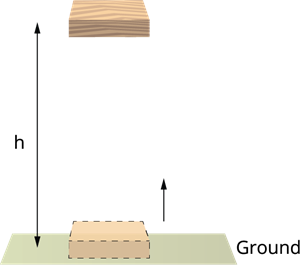PDF chapter test TRY NOW
An object rises its energy when lifted to a certain height. This is because work is done on it opposite to gravity while it is being raised. The energy possesses in such an object is the gravitational potential energy.
The gravitational potential energy of an object at a point above the ground level is defined as the work done in raising it from the ground to that point against gravity.
It is easy to derive an expression for the gravitational potential energy of an object at a height.
Let us consider an object with mass (m).

Let it be lifted through a height, (h) from the ground.
A force is required to do this. The minimum force needed to lift the object is equal to the weight of the object, mg.
The object gains energy equal to the work done on it.
Let the work done on the object against gravity be W. That is,
Since,
,
Energy equal to mgh units is gained by the object. mgh is the potential energy of the object.
